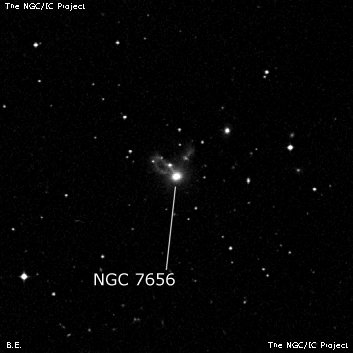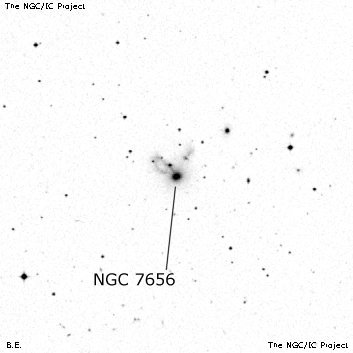NGC/IC Project Restoration Effort
(This is a very very beta version)
NGC7656


Basic Information
Location and Magnitude
Right Ascension: 23:24:31.5
Declination: -19:3:33
Constellation: AQR
Visual Magnitude: 13.5
Historic Information
Discoverer: Leavenworth
Year of discovery: 1885
Discovery aperture: 26.3
Observational
Summary description: vF, vS, R, bMN
Sub-type: S0
Corwin's Notes
=====
NGC 7656 is a peculiar S0, the brightest in a relatively sparce group. It has
a broad plume to the northwest and a virtually complete loop to the northeast.
The plume has a faint companion involved in its southeastern end of the plume,
and the loop has at least three companions, knots, or stars involved.
My previous position for the loop was the approximate center chosen by eye.
For this iteration, I've adopted the mean value of the three 2MASS PSC
sources -- plus one of my own SkyView estimates for a knot too faint to show
up in the PSC -- strung out along the loop, regardless of their classification
or actual physical involvement. The resulting mean position is close to the
previous eyeball estimate.
Steve's Notes
=====
NGC 7656
48" (11/1/13): at 488x and 610x appeared fairly faint to moderately bright, round, ~24" diameter, high surface brightness. Surprisingly, a low surface brightness wing or loop extending to the northeast was immediately noticed. This loop is brighter along the northern edge and passes through a mag 16.7 star (or stellar galaxy), increasing the overall length to 45" extending southwest (core) to northeast (loop). A mag 16.5 star lies 1.3' W and another mag 16.5 star is 1.4' N. 2MASX J23242536-1902139, an extremely compact galaxy (V = 15.7) lies 1.9' NW. Finally, 2MASX J23243030-1903019, an extremely faint quasi-stellar galaxy was glimpsed less than 30" NNW, although another loop in that direction was not seen.
24" (9/30/16): at 282x; fairly faint, fairly small, slightly elongated, 20" diameter, contains a small slightly brighter nucleus. ESO 605-004, 13' WNW, appeared very faint, fairly small, roundish, 20" diameter, low even surface brightness. ESO 605-006, 14' NE, was only occasionally glimpsed as an extremely faint glow, small, ~15" diameter, possibly elongated. The trio is catalogued as KTS 72 (Karachentsev Triplets, South).
24" (8/23/14): fairly faint, fairly small, round, 20"-24" diameter, weak concentration. The loop structure to the northeast was not noticed. ESO 605-004 lies 13' WNW.
17.5" (10/21/95): very faint, small, round, 30" diameter. Contains a very small brighter core surrounded by a very faint halo. This is an unusual, distorted interacting system with loops and filaments, though no structure was seen.



